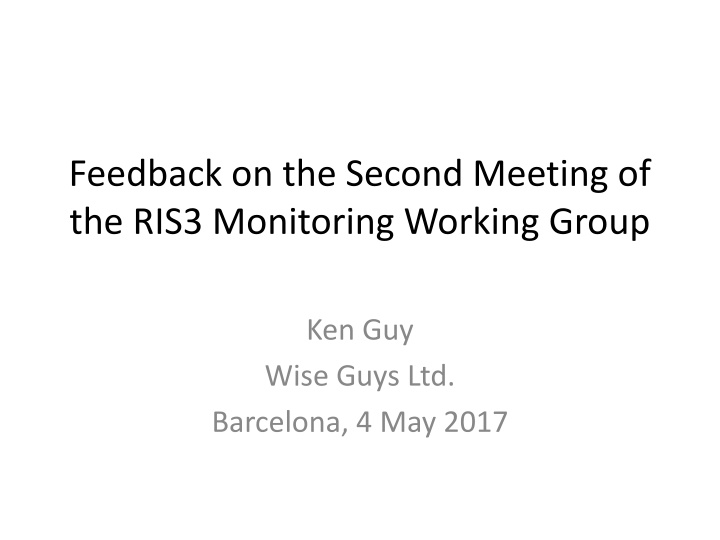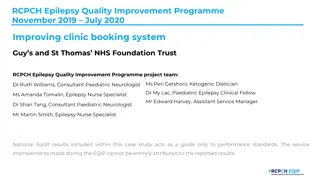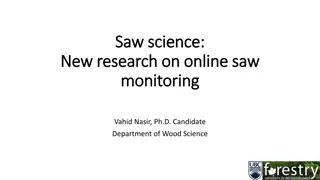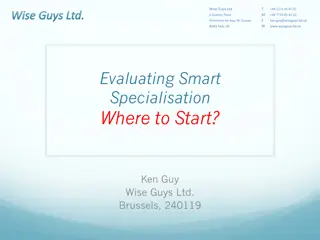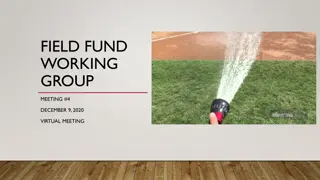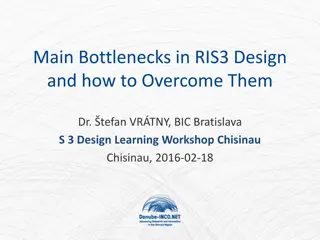Insights from RIS3 Monitoring Working Group Meeting at Ken Guy Wise Guys Ltd.
The feedback from the second meeting of the RIS3 Monitoring Working Group at Ken Guy Wise Guys Ltd. in Barcelona highlighted key tasks, including presentations on monitoring exercises, participatory exercises, and the RIS3 Monitoring Clinic. The presentation emphasized humor in communication, while participatory exercises and the CENTRO Monitoring Clinic discussed challenges around stakeholder involvement and monitoring indicators. Recommendations were made for future interventions in the CENTRO region. The meeting showcased the importance of effective monitoring strategies and stakeholder engagement in RIS3 implementation.
Download Presentation

Please find below an Image/Link to download the presentation.
The content on the website is provided AS IS for your information and personal use only. It may not be sold, licensed, or shared on other websites without obtaining consent from the author.If you encounter any issues during the download, it is possible that the publisher has removed the file from their server.
You are allowed to download the files provided on this website for personal or commercial use, subject to the condition that they are used lawfully. All files are the property of their respective owners.
The content on the website is provided AS IS for your information and personal use only. It may not be sold, licensed, or shared on other websites without obtaining consent from the author.
E N D
Presentation Transcript
Feedback on the Second Meeting of the RIS3 Monitoring Working Group Ken Guy Wise Guys Ltd. Barcelona, 4 May 2017
Feedback My main tasks of the day were to: Deliver a presentation on ways of ensuring that the results of monitoring exercises are taken into account by policymakers Take part in a participatory exercise concerning three aspects of theory versus practice Participate in the RIS3 Monitoring Clinic concerning the CENTRO region
Presentation The main point I took away from the presentation concerned the efficacy of humour as a means of communicating key messages The presentation failed to include a cautionary note about the use of humour Accordingly, I have altered my slides to reflect the perils of deploying items of dubious humour
Participatory Exercise Monitoring RIS3 vs. Monitoring OP The main challenge for RIS3 stems from the existence of silos and the lack of strong collective ownership. This hampers the definition of adequate indicators, the collection of relevant data and the eventual uptake of analytical outputs The Participatory Nature of Monitoring The main challenges are: (1) attracting stakeholders; (2) ensuring the right mix of stakeholders; and (3) maintaining the interest of stakeholders over time Indicators, Targets and Methods The main challenges concerning the definition of relevant indicators, targets and methods are pragmatic in nature and dictated by resource constraints
CENTRO Monitoring Clinic The main discussion in this clinic was between the CENTRO and IPTS representatives My own involvement was limited by my relative lack of knowledge concerning the specificity of the development of RIS3 in the CENTRO region One problem appeared to be the choice of a starting point for an intervention logic approach (thematic domains vs. innovation hubs) Both are acceptable, but the latter should be more rewarding given the effort that has gone into the elaboration of detailed lines of action for each hub However, the large number of action lines elaborated makes the task of outlining detailed monitoring indicators inordinately onerous If there is a further clinic in the next RIS 3 Monitoring Working Group meeting on 6 June, my own contribution would benefit from a prior discussion with the IPTS representative concerning the problems faced in the CENTRO region
